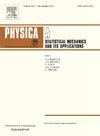Simulating pedestrian movement in T-junction corridor: A novel vision-driven convolutional graph attention model with a dataset from experiments
IF 2.8
3区 物理与天体物理
Q2 PHYSICS, MULTIDISCIPLINARY
Physica A: Statistical Mechanics and its Applications
Pub Date : 2025-06-16
DOI:10.1016/j.physa.2025.130775
引用次数: 0
Abstract
With the rapid pace of urbanisation, the safety and efficiency of pedestrian traffic face increasingly severe challenges, particularly in densely populated public areas. Optimising pedestrian flow effectively has therefore become a critical issue requiring urgent attention. To address this challenge, this study proposes a vision-driven convolutional graph attention model (VI-CGAM) for simulating pedestrian future movements. The VI-CGAM comprises three components: a visual information-based interaction graph construction module, a graph attention network-based spatial feature extraction module, and a convolutional neural network-based temporal feature extraction module. In addition, this study conducted a series of experiments on pedestrian diverging and merging in T-junction of varying widths, collecting key data using unmanned aerial vehicle to construct a novel T-junction pedestrian movement dataset. The results show that VI-CGAM accurately simulates pedestrian trajectories, as well as the density and flow rate characteristics in key areas. Furthermore, ablation studies were conducted to demonstrate the effectiveness of each component of VI-CGAM. This study provides a robust algorithmic support and valuable data resources for intelligent transportation systems, with the potential to improve pedestrian flow management and safety planning in public spaces.
模拟t型路口走廊行人运动:基于实验数据集的视觉驱动卷积图注意模型
随着城市化进程的加快,行人交通的安全和效率面临着越来越严峻的挑战,特别是在人口密集的公共区域。因此,有效地优化行人流量已成为一个迫切需要关注的关键问题。为了解决这一挑战,本研究提出了一个视觉驱动的卷积图注意模型(VI-CGAM)来模拟行人未来的运动。VI-CGAM由三个部分组成:基于视觉信息的交互图构建模块、基于图注意网络的空间特征提取模块和基于卷积神经网络的时间特征提取模块。此外,本研究还进行了一系列不同宽度t型交叉口行人分流和合并实验,利用无人机收集关键数据,构建了新的t型交叉口行人运动数据集。结果表明,VI-CGAM能够准确地模拟行人轨迹,以及关键区域的密度和流量特征。此外,还进行了消融研究,以证明VI-CGAM各成分的有效性。该研究为智能交通系统提供了强大的算法支持和宝贵的数据资源,具有改善公共空间行人流量管理和安全规划的潜力。
本文章由计算机程序翻译,如有差异,请以英文原文为准。
求助全文
约1分钟内获得全文
求助全文
来源期刊
CiteScore
7.20
自引率
9.10%
发文量
852
审稿时长
6.6 months
期刊介绍:
Physica A: Statistical Mechanics and its Applications
Recognized by the European Physical Society
Physica A publishes research in the field of statistical mechanics and its applications.
Statistical mechanics sets out to explain the behaviour of macroscopic systems by studying the statistical properties of their microscopic constituents.
Applications of the techniques of statistical mechanics are widespread, and include: applications to physical systems such as solids, liquids and gases; applications to chemical and biological systems (colloids, interfaces, complex fluids, polymers and biopolymers, cell physics); and other interdisciplinary applications to for instance biological, economical and sociological systems.

 求助内容:
求助内容: 应助结果提醒方式:
应助结果提醒方式:


